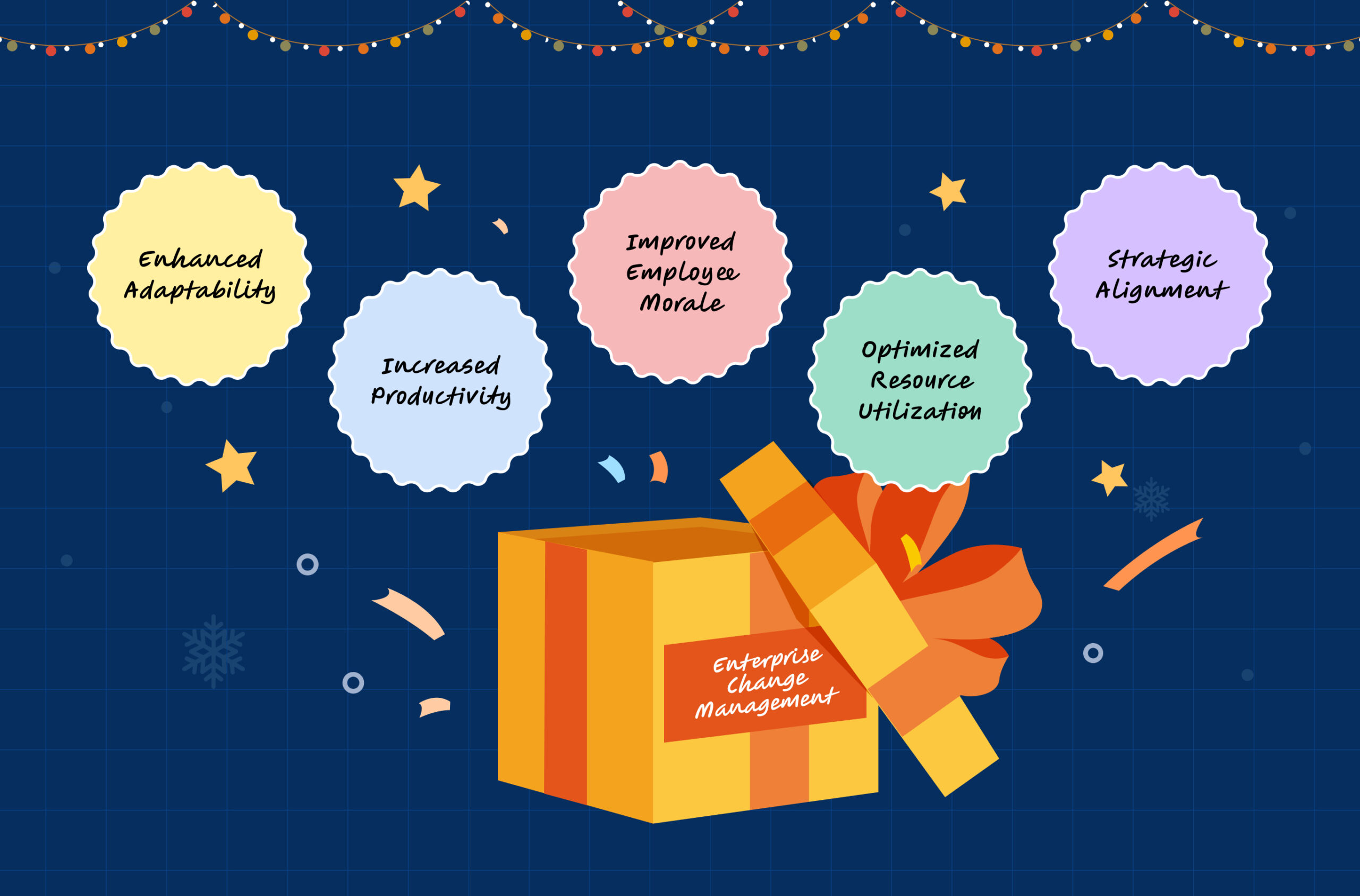As we stand on the threshold of a new year, with the twinkling lights of the holiday season illuminating our path, it’s not just the festive cheer that fills the air; it’s also the anticipation of what lies ahead in the ever-evolving landscape of business and technology.
If you are in a place where it’s snowing, the fluttering snowflakes often remind me of the pace of change, both metaphorically and literally. You go to sleep with autumn outside and wake up to snow covered everything one fine day. Similar to how enterprises suddenly found themselves navigating through uncharted territories of generative AI.
Change is the only constant, they say; this adage resonates even more profoundly for enterprises. The pace of technological advancement, especially with generative AI technologies, demands a strategic approach to manage and adapt to change. This is where enterprise change management steps in—a structured process designed to facilitate organizational transition, ensuring that the impact of change is not only understood but embraced.
We delve into the insights shared by industry experts who have witnessed and contributed to the evolution of enterprise change management in this era of generative AI and digital transformation. Treat their experiences like ornaments adorning the festive tree.
As we bid adieu to the challenges of the past, let’s prepare to unwrap the gift of enterprise change management this new year!

What is enterprise change management?
Enterprise change management is a holistic and systematic approach organizations take to deal with change. This transition involves individuals, teams, and the entire organization, taking them from a current state to a desired future state. Change management in an enterprise is a structured process that manages the human side of change to achieve the intended business outcomes. Enterprise change management is not just limited to implementing new technologies or altering processes; an enterprise change management strategy is also concerned about steering the entire organization through a cultural shift that aligns with its overarching goals.
Why is enterprise change management important?
The recent adoption of AI in the corporate landscape represents more than just a technological upgrade; it signals a fundamental shift in how businesses operate and thrive in the digital era. In this context, the importance of enterprise wide change management cannot be overstated.
Enterprise change management ensures that changes are smoothly and successfully implemented, and that the long-term benefits of change are realized.
Enterprise change management is important because it helps in:
- Navigating the complexity of change
- Overcoming resistance and driving acceptance
- Aligning organizational culture with technological innovation
- Maximizing ROI and ensuring sustainable change
- Mitigating risks
- Building a resilient workforce
What are the four types of change management in enterprises?
Change management is not a one-size-fits-all approach; it varies based on the nature of the change being implemented. There are four primary types of enterprise change management strategies:
- Developmental changes involve continuous improvement and incremental adjustments.
- Transitional changes are more significant, often involving a shift from one state to another.
- Transformational changes are radical and reshape the organization at its core.
- Remedial changes step in to correct the course when something isn’t working.
What are the 5 C’s of change management?
The enterprise change management framework consists of 5 C’s to guide organizations through the change process: Culture, Communication, Courage, Commitment, and Compassion. Each ‘C’ plays a vital role in ensuring that change is not only implemented but also embraced and sustained within the enterprise.

1. Culture:
Culture eats strategy for breakfast, as the saying goes. The culture of an organization plays a pivotal role in determining how change is embraced. Creating a culture of learning and unlearning, innovation and experimentation, collaboration and adaptability, and most importantly of compassion, is crucial.
2. Compassion:
Compassion and trust are the glue that hold change together. Compassion fosters an environment for acknowledging and addressing employees’ concerns and aspirations. Compassion is about understanding and alleviating anxieties that change often brings along. Compassion and trust are tied to the culture of an organization, and are often led by leaders.
3. Communication:
Communication is the bedrock of enterprise change management. Transparent, timely, and two-way communication ensures that everyone understands the ‘why’ and ‘how’ behind the changes. For instance, AI has filled many employees with the fear of becoming obsolete. Explaining the benefits of adopting AI in enterprise processes and addressing concerns about how AI affects certain job roles is paramount.
4. Courage:
Change requires courage. Organizations are often comfortable in the status quo. Changing it means coming out of the comfort zone and taking charge. Courage isn’t just about facing resistance, it’s as much about instilling confidence and ensuring that employees can effectively work with and leverage new technologies. Leaders need to embody courage by supporting and inspiring all stakeholders.
5. Commitment:
Change often meets resistance, but commitment helps to overcome it. Leaders must demonstrate unwavering support for the change, setting an example for others. With a top down approach, it is important for top management, middle management, front line employees and other stakeholders to commit to change in all their endeavors. Conviction to change involves fostering a culture that values continuous learning and embraces the evolving role of technology in the workspace.
What are the benefits of enterprise change management?

The advantages of embracing enterprise wide change management are manifold:
1. Enhanced adaptability and agility:
Change management equips organizations with the tools to adapt to evolving technologies. Employees are prepared for the shift, and the organization becomes more agile in the face of change.
2. Increased productivity and efficiency:
Efficiently managed change ensures minimal disruptions to workflows. This translates to optimized processes, faster decision-making, and ultimately, heightened productivity.
3. Improved employee morale:
Change can be unsettling, but a well-managed process fosters a sense of security. In the AI era, addressing concerns about job displacement and emphasizing the complementary role of AI can boost morale.
4. Optimized resource utilization:
Change management helps in identifying gaps and utilizing resources effectively, this means strategically deploying technologies where they can bring the most value.
5. Strategic alignment:
Change management ensures that the organizational compass aligns with strategic goals. A new technology must be seen as a strategic asset rather than just a tool.
Gaurav Sharda
Steps and tips to ensure effective enterprise change management
Enterprise change management programs can falter for various reasons, such as lack of leadership support, poor communication, resistance to change, inadequate training, and failure to embed changes into the corporate culture. Understanding these pitfalls is the first step towards mitigating them and steering change efforts towards success.
To ensure an effective enterprise change management process, it is essential to develop a comprehensive enterprise change management strategy, with a nuanced understanding of the organizational dynamics, that includes stakeholder analysis, communication plans, training programs, and mechanisms for feedback and adjustment. It’s about creating a roadmap that is not only strategic but also empathetic to the human elements of change.
Here are some practical tips and steps to ensure success in the enterprise change management process:
1. Start with a comprehensive assessment:
Before embarking on an enterprise wide change management journey, conduct a thorough assessment of the current state of your organization. Understand the existing culture, identify potential challenges, and gauge the readiness of your workforce.
Gaurav Sharda
2. Engage leadership from the onset:
Leadership plays a pivotal role in driving change. Ensure that key leaders are not only on board but actively championing the cause. Their commitment sets the tone for the entire organization.
3. Prioritize communication:
Clearly articulate the reasons behind adopting new technologies, address concerns, and provide regular updates on the progress. Foster an environment where questions are welcomed and answered promptly.
Gaurav Sharda
4. Invest in training and development:
Invest in training programs that equip your workforce with the knowledge and skills required to work seamlessly with new technologies. This not only boosts confidence but also ensures optimal utilization of the new tools and technologies.
5. Create a change network:
Establish a network of change advocates within your organization. These individuals can act as conduits of information, helping to disseminate updates, address concerns, and ensure that the change message permeates through all levels.
6. Monitor and adjust:
Change is a dynamic process. Regularly monitor the implementation, gather feedback, and be prepared to make adjustments. This flexibility is especially crucial in the present landscape, where advancements happen rapidly.
7. Celebrate small wins:
Acknowledge and celebrate milestones, no matter how small. This fosters a positive environment and reinforces the benefits of the change. Celebrate small milestones and successful pilots to encourage a culture of innovation.
8. Foster a continuous learning culture:
Foster a culture of continuous learning where employees are encouraged to stay updated on the latest trends, attend relevant training, and share their knowledge with colleagues.
Roland Schmid
9. Measure and demonstrate ROI:
Quantify the impact of change by measuring key performance indicators (KPIs) relevant to your organization.This could include improvements in efficiency, cost savings, or enhanced customer experiences. Demonstrating tangible returns reinforces the value of the change.
The effective management of enterprise change is not just a necessity but a strategic imperative. As organizations grapple with the rapid evolution of technology, the implementation of robust change management processes becomes paramount.
Enterprise change management: Hear about the best practices from industry leaders
Inclusive approach to change
Gaurav Sharda, CTO at Beacon Mobility, orchestrated a remarkable AI journey by embracing an inclusive change approach. Recognizing the potential of AI in addressing real-time challenges across diverse functions, Beacon Mobility engaged employees from various roles in the early stages of their AI adoption. This frontline involvement not only comprehensively understood user needs but also identified 100 critical questions that AI could address.
The result was a tool that emerged as a response to workforce needs, fostering excitement and a profound sense of ownership. Beacon Mobility’s initiative exemplifies the essence of an inclusive enterprise change management process, where the workforce actively participates in shaping the transformation.

The power of pilots
Feroz Sheikh, from Syngenta Group, provides an insightful journey into overcoming acceptance challenges faced by agronomists in adopting AI recommendations. The computational agronomy team’s AI algorithm, initially met with skepticism, gained credibility through pilot programs. The key was aligning AI capabilities with the agronomists’ expertise, transforming the algorithm into a cornerstone for seed selling.
Syngenta’s AI insights and experiences underscore the importance of pilots and aligning enterprise change management programs with domain expertise, ensuring that AI seamlessly integrates with existing knowledge and practices.

A Continuous Change Management Journey
Roland Schmid, from Syngenta Group, sheds light on the company’s commitment to a more profound transformational journey. The company launched the AI Accelerator, a 10-day training program aimed at providing hands-on experience with AI tools like Chat GPT and other generative AI tools. The training program, designed to not only enhance efficiency in daily work, but, also sensitizes employees to the capabilities and risks associated with AI. By actively involving teams in a pilot AI training initiative, Syngenta aims to instill confidence and mitigate fears around AI technologies. The approach is pragmatic, acknowledging that change management is an ongoing process rather than a one-time milestone. It not only equips employees with practical skills to leverage AI tools but also fosters a culture of continuous learning and adaptability. As AI becomes an integral part of the organizational fabric, sensitizing the workforce to technological nuances is crucial.







